

Karkur Talh & Karkur Murr rock art sites
The eastern, sandstone part of the mountain is dominated by a large valley system with numerous side wadis, eventually draining to the plains to the North-east. To this day this valley, Karkur Talh, supports the densest growth of vegetation anywhere in the central Libyan Desert, and in prehistoric times it must have been a small isolated patch of lush savana among the already bare and dry rocks and plains. Karkur Murr is a small narrow rocky wadi that drains to the south, but the two are only divided by a low watershed, the two are essentially the same habitat areas. This system of wadis contains innumerable representations of prehistoric rock art, on par with the In-Habeter - Mathendous (Messak Settafet, Libya) and Sefar (Tassili N'Ajjer, Algeria) localities as the richest concentrations of rock art anywhere in the Sahara. It is one of my ambitions to locate and document all sites in this incredibly rich area. The following is just a small sample.
Karkur Talh - Engravings (main valley)
The central section of the main valley contains a very large number of engravings, mainly concentrated on the south bank. (Possibly because only the south bank offers shade during midday, making it a more favorable habitat.) The majority of the engravings fall into one of the following categories:
Wild Fauna
Probably the earliest rock art in the area. The only large african animal represented is the giraffe. The absence of elephants and rhinoceros seems to indicate that these engravings are younger than the earliest ones in the central saharan massifs. Most of the engravings are small, 30-50cm, there is a single example of a giraffe exceeding one metre in dimension. Aside the giraffe, other semi-desert fauna is represented: ostrich, addax, barbary sheep, oryx, gazelle. As the latter have lived in the area till recent times, the representations of wild fauna without giraffe could belong to more recent periods, contemporary with the bovids.
Frequently the animals (giraffe and ostrich) are shown tethered, probably caught in some kind of a trap, or held at the neck by a leash.
Bovids
The most numerous engraved images, both single bovids and complete herds, sometimes acompanied by human figures. Occasionally the bovids are associated with giraffes, probably in the earliest phase of the bovidian period.
Rams
There are a few representations of rams, generally in the same style as bovids, probably from the same general period.
Human figures
Crudely drawn human figures with long spears and shields (and other unidentified objects) seem to be always associated with bovids. There are also several representations of "horned" human figures, sometimes associated with giraffes.
Hunting scenes
There are numerous examples of crudely engraved scenes of humans and dogs chasing barbary sheep and occasionally other wild animals. Their age is uncertain, but judging the style they probably belong to the later (younger) periods.
Camel period engravings
As elsewhere in the Sahara, the final phase is characterised by crude engravings of camels in various styles. The youngest of these may have been made by the Tibou nomads a few hundred years ago.
Karkur Talh - Paintings (main valley)
Contrary to engravings, the paintings in the central section almost exclusively concentrate on one topic, cattle. While stylistic differences enable some crude segregation of earlier and later periods, they all belong to the bovidian phase. In the central part of the valley that was explored by the early visitors, there are relatively few, smaller paintings.
Karkur Talh - South branch
Aside some engravings, there is a particularly large shelter near the end of the main southern branch of the valley, that is covered by paintings. It was discovered by Almásy in autumn, 1933, and was the most impressive of the painted sites until the Belgians' discoveries 35 years later.
Karkur Talh - Winkler's Site 81
In 1938 Winkler spent some time exploring the side valleys, and during these trips, came accross a unique site near the watershed towards Karkur Murr. The site itself is clearly from the later part of the bovidian period, but the strange symbols and shapes are without parallel, and their meaning is unknown. (It has been suggested, that the star like shapes represent animal traps, but it's just speculation). The superb montage was made by Jean-Marc Mercier.
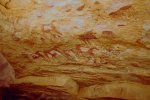

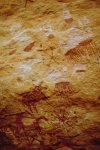
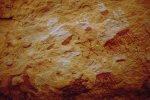
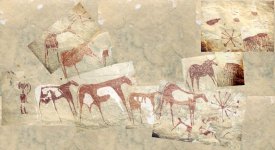
Composite photo courtesy Jean-Marc Mercier
Not far from this site, in march 2001 we have come upon a shelter that contains amongst more conventional bovids and humans, one of the rare painted representations of giraffe.
Karkur Talh - The Belgians' Sites
While all above sites are impressive enough, the most spectacular discoveries were made by the belgian expedition in 1968. Far from the main concentration of sites, they came unexpectedly on a very large shelter, some 30 metres long, that is covered by superb paintings of the late bovidian phase, some showing humans in the characteristic Karnasahi style.
Nearby a further six smaller shelters have been found with paintings of similar quality.
Karkur Murr
In 1938, Bagnold & Peel discovered a large painted shelter somewhere near the upper reaches of Karkur Murr, that was published by Winkler (site 75). To my knowledge this site has not been visited since by anyone.
In March 2001 we have found a small shelter with painted cattle and unique engravings near the middle section of Karkur Murr.
Recent Discoveries
In March 2002, Jean-Marc Mercier and party located three shelters that were hitherto unknown, all containing beautiful paintings. Many thanks for the permission to reproduce these photos here !
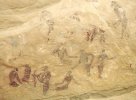
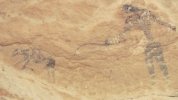
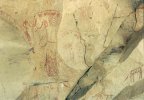

Photos and composite courtesy Jean-Marc Mercier

|

|

|